
The Second Battle of El Alamein was a battle of the Second World War that took place near the Egyptian railway halt of El Alamein. The First Battle of El Alamein and the Battle of Alam el Halfa had prevented the Axis from advancing further into Egypt.

Operation Torch was an Allied invasion of French North Africa during the Second World War. Torch was a compromise operation that met the British objective of securing victory in North Africa while allowing American armed forces the opportunity to engage in the fight against Nazi Germany on a limited scale. It was the first mass involvement of US troops in the European–North African Theatre, and saw the first major airborne assault carried out by the United States.

The Allied invasion of Sicily, also known as the Battle of Sicily and Operation Husky, was a major campaign of World War II in which the Allied forces invaded the island of Sicily in July 1943 and took it from the Axis powers. It began with a large amphibious and airborne operation, followed by a six-week land campaign, and initiated the Italian campaign.

The King's African Rifles (KAR) was a British Colonial Auxiliary Forces regiment raised from Britain's East African colonies in 1902. It primarily carried out internal security duties within these colonies along with military service elsewhere during the world wars and other conflicts, such as the Malayan Emergency and the Mau Mau uprising. The regiment's enlisted soldiers were drawn from the native Africans, while most officers were seconded from the British Army. During the 1960s, as part of the decolonisation of Africa, more African officers were commissioned into the regiment before it was gradually disbanded. KAR battalions would go on to form the core of newly established armed forces throughout East Africa.
From 1939 to 1940, the French Third Republic was at war with Nazi Germany. In 1940, the German forces defeated the French in the Battle of France. The Germans occupied the north and west of French territory and a collaborationist régime under Philippe Pétain established itself in Vichy. General Charles de Gaulle established a government in exile in London and competed with Vichy France to position himself as the legitimate French government, for control of the French overseas empire and receiving help from French allies. He eventually managed to enlist the support of some French African colonies and later succeeded in bringing together the disparate maquis, colonial regiments, legionnaires, expatriate fighters, and Communist snipers under the Free French Forces in the Allied chain of command. In 1944, after the Allies had landed in Normandy and the southern front moved from North Africa across the Mediterranean into Italy and Provence, these forces routed the German Army, and Vichy officials fled into Germany.

The North African campaign of the Second World War took place in North Africa from 10 June 1940 to 13 May 1943. It included campaigns fought in the Libyan and Egyptian deserts and in Morocco and Algeria, as well as Tunisia.

The Tunisian campaign was a series of battles that took place in Tunisia during the North African campaign of the Second World War, between Axis and Allied forces from 17 November 1942 to 13 May 1943. The Allies consisted of British Imperial Forces, including a Greek contingent, with American and French corps. The battle opened with initial success by the German and Italian forces but the massive supply interdiction efforts led to the decisive defeat of the Axis. Over 250,000 German and Italian troops were taken as prisoners of war, including most of the Afrika Korps.
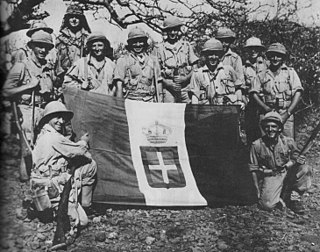
The East African campaign was fought in East Africa during the Second World War by Allies of World War II, mainly from the British Empire, against Italy and its colony of Italian East Africa, between June 1940 and November 1941. The British Middle East Command with troops from the United Kingdom, South Africa, British India, Uganda Protectorate, Kenya, Somaliland, West Africa, Northern and Southern Rhodesia, Sudan and Nyasaland participated in the campaign. These were joined by the Allied Force Publique of Belgian Congo, Imperial Ethiopian Arbegnoch and a small unit of Free French.
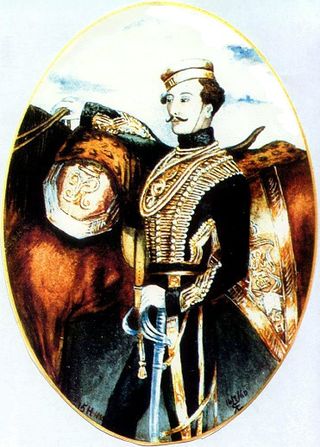
Louis Edward Nolan was a British Army officer and cavalry tactician best known for his role and death in the Charge of the Light Brigade during the Crimean War. Born to a minor diplomatic official and his wife, Nolan was educated at the Austrian Inhaber Pioneer School at Tulln, where he was noted as an enthusiastic horseman and military theorist. After early graduation he was commissioned as a subaltern in the 10th Austrian Hussar regiment, serving in Austria, Hungary and on the Polish frontier, where he again became known for his horsemanship and was promoted to senior lieutenant. Due to the nepotism inherent in the Austro-Hungarian armed forces, Nolan succeeded in transferring to the British Army as a Cornet in the 15th Light Dragoons.

The Syria–Lebanon campaign, also known as Operation Exporter, was the invasion of Syria and Lebanon in June and July 1941 by British Empire forces, during the Second World War.

The 70th Infantry Division was an infantry division of the British Army that fought during the Western Desert Campaign of the Second World War. What would become the 70th Division originated with the 7th Infantry Division, which was formed in 1938 to serve in the British Mandate of Palestine during the Arab Revolt. This division then transferred to Egypt on the outbreak of the Second World War and soon became the 6th Infantry Division, which went on to take part in the Battle of Crete and the Syria–Lebanon Campaign. On 10 October 1941, the 6th Division was re-created as the 70th Infantry Division, in an attempt to deceive Axis intelligence concerning the strength of British forces in the Middle East.
The Battle of Latema Nek was a battle of the East African Campaign in World War I.
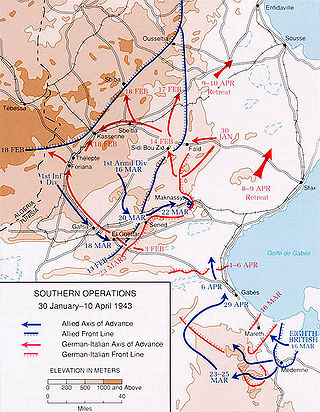
The Battle of Wadi Akarit was an Allied attack from 6 to 7 April 1943, to dislodge Axis forces from positions along the Wadi Akarit in Tunisia during the Tunisia Campaign of the Second World War. The Gabès Gap, north of the towns of Gabès and El Hamma, is a passage between the sea and impassable salt marshes. The 51st (Highland) Infantry Division breached the defences and held a bridgehead, allowing the passage of their main force to roll up the Axis defences. After several determined counter-attacks, the Axis forces withdrew and the Eighth Army, under General Bernard Montgomery, pursued toward Tunis, until reaching Axis defensive positions at Enfidaville.

The involvement of the British Colony of Kenya in World War II began with the declaration of war on Nazi Germany by the British Empire in September 1939.
The Nandi Resistance was a military conflict that took place in present-day Kenya between 1890 and 1906. It involved members of the Kalenjin ethnic group, mainly from the Nandi section, and the British colonial administration. The close of the 19th century, a time referred to as the "pacification period" by Matson, saw a number of local populations that resisted British colonial rule. Of these, the Nandi resistance would stand out for being the longest and most tenacious.
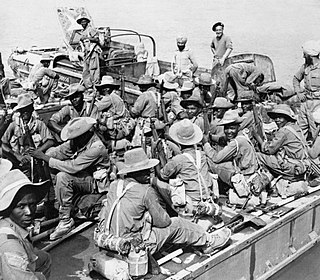
The involvement of the Nyasaland Protectorate in World War II began with the declaration of war on Nazi Germany by the British Empire in September 1939. Though no combat occurred in Nyasaland itself, it remained an economic asset for the Allies and also contributed a significant number of soldiers to fight in the British Army.
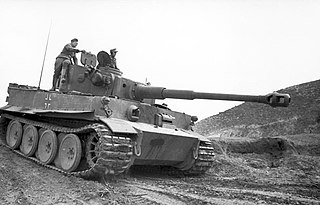
Unternehmen Ochsenkopf also known as the Battle of Sidi Nsir and the Battle of Hunts Gap was an Axis offensive operation in Tunisia from 26 February to 4 March 1943, during the Tunisia Campaign of the Second World War. The offensive and a subsidiary operation Unternehmen Ausladung was intended to gain control of Medjez el Bab, Béja, El Aroussa, Djebel Abiod and a position known as Hunt's Gap, between the British First Army and the Axis Army Group Africa. The offensive gained some ground, but none of the more ambitious objectives were achieved before the operation was called off due to increasing losses of infantry and tanks, particularly the heavy Tigers. Unternehmen Ochsenkopf was the last big Axis offensive by the 5th Panzer Army before the surrender of the Afrika Korps in May 1943.

The siege of Saïo or battle of Saïo took place during the East African Campaign of World War II. Belgo-Congolese troops, British Commonwealth forces and local resistance fighters besieged the fort at the market town of Saïo in south-western Ethiopia in 1941. The siege lasted for several months, culminating in an Allied attack on the Italian garrison thereby forcing it to surrender.

The Battle of Tug Argan was fought between forces of the British Empire and Italy from 11 to 15 August 1940 in British Somaliland. The battle determined the result of the Italian conquest of British Somaliland after the Italian invasion and the larger East African Campaign of the Second World War.

The Battle of Lioma was fought between the German Empire and British Empire during the East African Campaign of World War I. Having successfully evaded the Allies since late 1917, the German Schutztruppe under Paul von Lettow-Vorbeck waged a guerilla campaign in Portuguese East Africa, attacking and raiding settlements as well as forts in the search of supplies while inflicting as much damage as possible on the Allies. All the while, the Schutztruppe was chased by the British King's African Rifles, which finally cornered the Germans at the village of Lioma on 30–31 August 1918. Led by George Giffard, the British forces almost managed to encircle and destroy the Schutztruppe, but in the end the Germans broke out and successfully retreated. Although greatly weakened by the fighting at Lioma, the Schutztruppe was thus able to remain active until the end of the war.
















